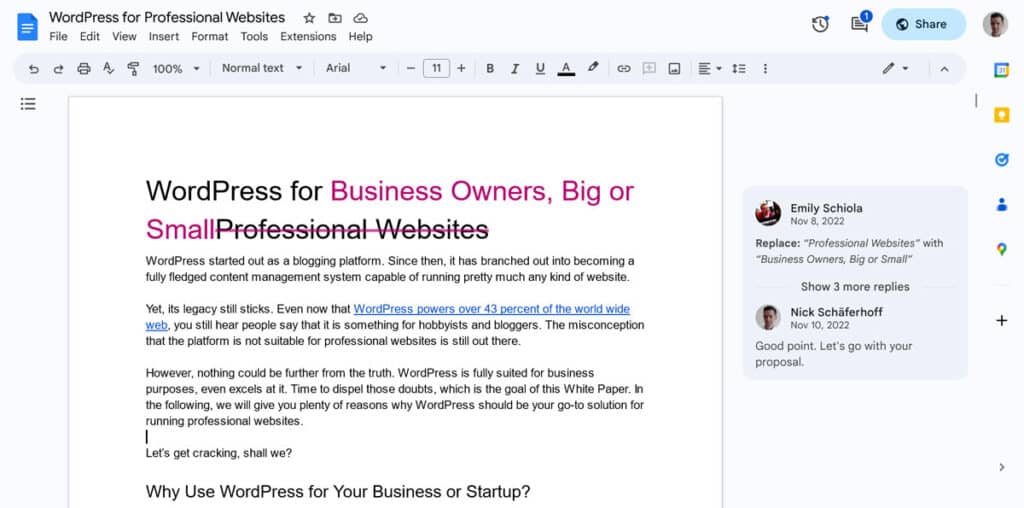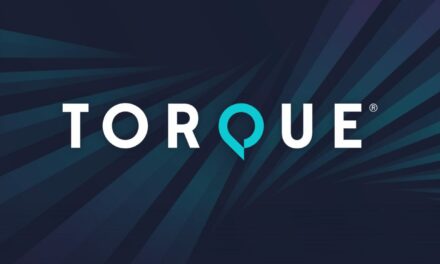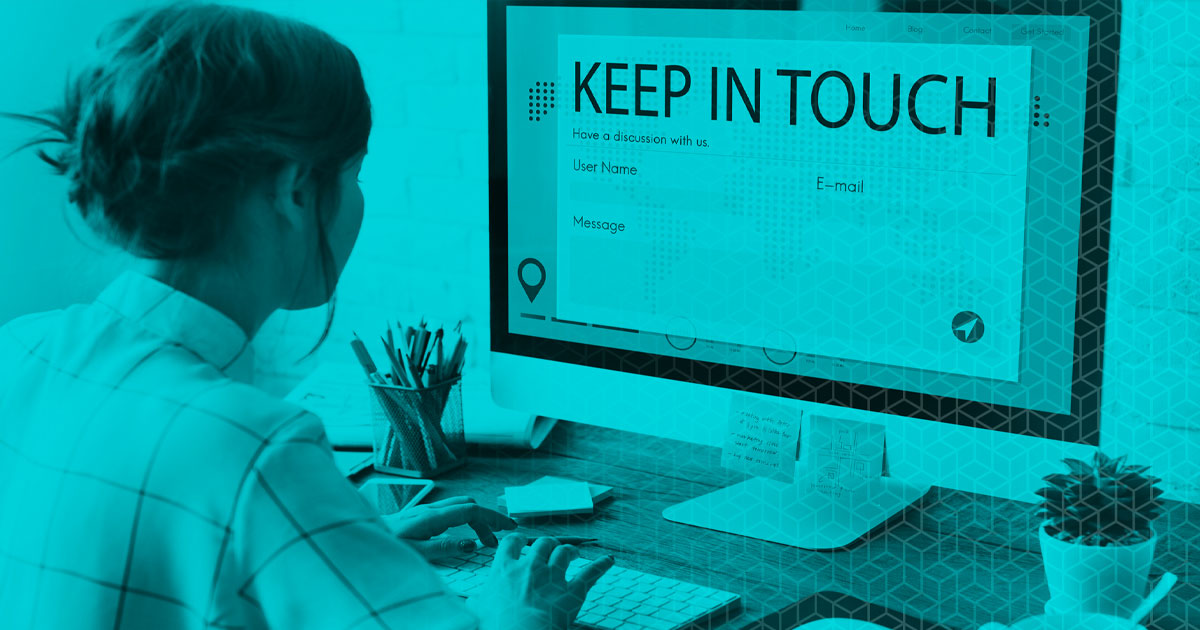Bringing real-time collaboration or collaborative editing to WordPress will be the focus of the third phase of the Gutenberg project. It started off with the block editor in WordPress 5.0 and has by now progressed to Full-Site Editing aka the WordPress Site Editor. Adding real-time collaboration will be the second-to-last phase, while the final phase will add native multilingual capabilities.
Lead Architect Matias Ventura recently posted a preliminary outline of what is planned for Phase 3. The planned changes will not only bring new functionality to WordPress but also necessitate rebuilding (large) parts of its interface. The developers also predict that collaborative editing is going to be the most challenging to build due to the scope.
Reason enough to take a detailed look at what we can expect. In the following, we will go over what real-time collaboration is, what’s planned for this update, and the consequences for the WordPress platform. We will also go over ways you can already try out more collaborative workflows on your WordPress website right now.
What is Real-Time Collaboration?
If you have ever worked on a Google document together with other people, you already know what collaborative editing is. It is the ability for several users to edit a document at the same time, comment on make changes to other people’s work, and use shared assets together.

This allows you to work on a single document collectively instead of giving each person a separate copy and combining their individual input later. You are also able to assign different roles to users that decide whether they can only see, comment on, or edit the content.
Doing so saves time and effort, improves communication, and allows you to divide the labor. It can also result in better outcomes and makes the current work product available to every team member at the same time.
Other software solutions also offer this functionality. Examples include Canva, Sketch, and Microsoft Office 365. However, it is currently not possible in WordPress, at least not by default. While you can work on content pieces together, it’s only possible to do so one user at a time. When one person is in the editing screen for a particular page or post, anyone else who tries to access it gets locked out or needs to kick out the original editor.
“Supporting these workflows is not just about concurrency, though, but also about lifting restrictions that have been present in WordPress for a long time, such as locking a post when two people try to edit at the same time,” Ventura said in the post.
With the planned real-time collaboration, it will be possible to work on content together as a team instead — right in the WordPress interface.
Why Do We Need Collaborative Editing in WordPress?
Yet, why is it the goal to implement this? After all, you could already simply use a Google document for the collaborative part and then copy over the result.
However, copying and pasting content from Google Docs to WordPress does not always work perfectly. It can lead to errors and need reformatting before you can publish the content. In addition, any images included in the document first have to make their way over to WordPress. With a native solution, none of this would happen.
In addition, there is a bit of a lack of collaboration tools in WordPress overall. Unless you install plugins for that purpose, there is no way to leave comments or feedback for other authors and users. Therefore, you often need to rely on other, asynchronous tools, like email or Slack to coordinate.

Doing so will also often result in one person having to implement the suggestions from the rest of the team. Seeing as many websites and content strategies are run by teams, giving people tools to collaborate directly in the environment they are working in would go a long way in making the creation process more seamless.
Plus, since the WordPress block editor can do both content and design, it would also help designers and content creators work together better. While one person can take care of the written part, the other can already start prettying it up.
Finally, offering real-time collaboration is also simply a good way to improve the WordPress CMS and make it into a mroe modern piece of software.
What Exactly Are the Developers Planning?
In his post, Matias Ventura lays out the preliminary goals and ideas the developers are focusing on. Here is a breakdown of what they include.
1. Real-time Content Collaboration
Naturally, this is the centerpiece of the entire phase. The goal is to provide the necessary infrastructure and UI to allow multiple users to work together on the same content simultaneously. To create, edit, and customize web pages and posts as a team.
2. Asynchronous Collaboration Tools
However, working together on content doesn’t just mean the ability to be inside the editor at the same time. You also need tools to communicate effectively about what you are doing. Gutenberg Phase 3 also aims to provide those, including things like:
- Draft sharing
- Inline block commenting
- Assignment review
- Improved version control
- Task management
Some of this is currently already possible through plugins but the goal is to make it native.
3. Improved Publishing Workflows
Another goal is to provide better tools for creating, editing, reviewing, and publishing content within WordPress. This can include features such as:
- Defining editorial requirements
- Setting customized goals, e.g. a certain number of words or images
- Prerequisites to complete before publishing is unlocked such as setting a featured image, etc.
- Support for multiple preview contexts (e.g. members vs no members)
The plan is not to necessarily include all of this in WordPress Core. However, Phase3 will provide the infrastructure to make it possible to implement this in the editor.
4. More Powerful Post Revisions
Naturally, to accommodate the added complexity, you need a more detailed post revision system. The plan is to make it “more visual, aware of individual blocks, and explore adding the ability to schedule revisions across multiple parts of a site”.
What does that mean?
First of all, it would add the ability to revert singular blocks to earlier versions, not just entire content pieces. Secondly, you would be able to update several content pieces at the same time, for example that belong to the same campaign.
5. An Enhanced Media and Asset Library
Another piece of WordPress that the developers want to work on is the media library. They want to provide not only a place for managing visuals but also blocks, block patterns, styles, and fonts.
As part of this, it is necessary to enhance the media library’s design and functionality. Historically this is a part of WordPress that hasn’t seen a lot of work, so it would be exciting to find out how they can improve it.
6. A Global Search and Command Component
The final component that Matias is talking about in connection with real-time collaboration in WordPress is a command prompt such as Spotlight in MacOS.

It would allow users to navigate directly to content or different admin areas as well as run commands like “create a new post” or “insert pattern”. This is also in response to the surge in AI and to introduce functionality that is prompt-based. A Github repository for this already exists.
Consequences of the Proposed Changes
From the above, it should already be obvious that this will not just be simply another feature that’s added to WordPress. These changes will make it necessary to rebuild and change parts of the WordPress user interface. As Matias says in his post:
To accomplish this, we’ll be looking beyond the editors at the rest of the admin experience.
Especially the library will likely see a lot of work. Other areas include update admin notices and UI design components as well as the admin list views used in posts, pages, categories, templates, comments, and by hundreds of plugins. Those should receive a more modern design and better support for interactivity and extensibility. You can find early concepts here.
So in short, real-time collaboration might change the very fabric of WordPress as we know it. We need to find entirely new workflows and design solutions to be able to incorporate it into the CMS.
That’s also the reason why real-time collaboration is on the roadmap before multilingual capabilities. Many of the workflows have to be already in place before we can tackle native translation options as Josepha Haden Chomphosy and Hector Prieto discuss in this podcast.
Technical Challenges for WordPress Real-Time Collaboration
Of course, to take on something of this magnitude, there are a number of technical challenges to overcome. As states in the podcast episode above, collaborative editing is going to be especially difficult because of the need for real-time communication between different user browsers. If you want to read about the kind of problems that arise from this, read this account by the people who make the CKEditor (in a word, conflicts!).
In addition, you need to take into consideration the diverse user base WordPress has and especially the different servers that they host their sites on.
For example, Google had an easier time to add collaborative editing to their tools because they are hosting them themselves and have full server control. As a consequence, they mostly had to solve for different browsers.
WordPress, on the other hand, runs on a myriad of server setups with various PHP versions and environments. Not all of them are equipped for all types of technical approaches. That’s also why no underlying technology has been chosen yet. Real-time collaboration is really in its early stages. It will take a lot more thinking and proofs of concept before a decision can be made.
Besides, the developers will continue to work on projects related to earlier phases of Gutenberg. That includes adding more blocks, improved tables, a grid layout system, and improving the block API.
How to Test Drive Collaborative Editing in WordPress Today
If you are really curious about the topic of real-time collaboration in WordPress, there are a number of working prototypes and plugins that let you try ou this functionality now:
- AsBlocks — Made by Riad Benguella, who works for Automattic, it demonstrates a collaborative editing experience inside the Gutenberg editor. You can try it out online here. It won’t look exactly like this but it shows one possibility. Read the accompanying blog post for more information.
- Block Collab — Another prototype by Enrique Piqeras. It seems like it’s not currently under active development but might still be usable.
- Multicollab — A plugin offering features such inline commenting, pinging users, marking comments as done, and email notifications. You can find a demo here (requires signup but comes with a 14-day free trial).
One of them or part of one of them might even be the basis for the final feature. It’s not the first time that something first developed as a plugin ended up in core. The WP REST API and Gutenberg itself both started out that way.
What Are Your Thoughts?
Real-time collaboration has been on the WordPress roadmap for a long time. After finishing up the first two phases of the Gutenberg project, it is now the next step. The preliminary roadmap offers an exciting vision of the future of WordPress in which you can work on content together with all the necessary features for effective collaboration, synchronous and asynchronous.
However, making it happen will need a lot of work and planning. The feature itself will probably change the WordPress platform as we know it and also to pave the way for the fourth phase and native multilingual support.
However, if past developments are any indication, it won’t happen quickly but over time. For example, it is not part of the 6.3 release coming in August 2023. So we will see. Until then, share thoughts and give your input on the official post.
Are you excited about collaborative editing in WordPress? What’s your favorite part? What are your concerns? Share in the comments!













